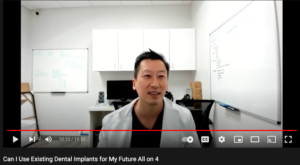All on 4-Implant Failed or Tooth Broken Off?
Did you know if you have an All on 4, you can experience the complications of an implant failing or your teeth breaking off? These complications can occur if your surgeon does not place your dental implants in the correct location. Obviously, either of these situations is a serious concern. If you lose an implant, it can compromise your entire All on 4 prostheses. If you lose a tooth, the decision has to be made as to why the tooth fell off and if placing additional implants will help prevent the issue from occurring again.
Why did an implant fail if it had been integrated successfully?
Your dental surgeon will typically wait 3 to 4 months to check to see if your dental implants have integrated with your bone successfully. Whether it is for a single implant or an All on 4, your body needs 3 to 4 months to osseointegrate with the dental implant. After that period, it is definitely more difficult for an implant to start failing. There are certain risk factors that can help precipitate implant failure. These would include smoking and uncontrolled diabetes. However, when it comes to All on 4, there are certain factors that can help precipitate implant failure that could be the fault of the surgeon. One factor includes excessive cantilevers. What’s meant by this is if the teeth of your prosthesis are hanging too far off from where there is a dental implant to support underneath, then this can cause an excessive cantilever. This will result in excess stress being placed on that implant and cause it to experience peri-implantitis and possible eventual implant failure.
Teeth Breaking off or your prosthesis breaking?
Not only can excessive cantilevers cause an implant to fail, but they can cause your prosthesis to break. This makes sense because if there is no support underneath the prosthesis, then the prosthesis will experience too much stress and fracture. This is especially more prone in an acrylic temporary prosthesis that was made via a chairside conversion process. The chairside conversion process includes a significant amount of adding and subtracting of acrylic to the denture prosthesis which results in a weak temporary prosthesis. Final prostheses such as zirconia and nanoceramic prosthesis tend to experience fewer fractures due to their strength. However, there are also rare instances of these fractures if there is not an implant relatively close to supporting the prosthesis. There is a rule of thumb that exists for how long the cantilever can be. For the upper jaw, it’s a good idea to only allow a maximum of about 8mm to be extended past your last implant. For the lower jaw, you can extend back approximately 1.5x the distance from your front implant to your back implant
Important anatomical structures to avoid
In theory, it would be easy to just space out the implants as wide as possible. However there are important anatomical structures your dental surgeon needs to avoid, that could affect where the dental implants can be placed. In the upper jaw (maxilla), the maxillary sinuses need to be avoided. In some patients, the sinuses can be very large and affect how far back your implants can be placed. In the lower jaw (mandible), the inferior alveolar nerve needs to be avoided. How high your inferior alveolar nerve is affected how far back your implants can be placed. As a result, the simplicity of dental implant placement on every patient depends on each individual’s unique anatomy.








